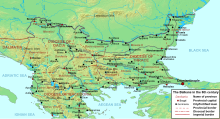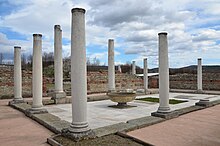Dacia Ripensis
| Dacia Ripensis | |||||||||
|---|---|---|---|---|---|---|---|---|---|
| Province of Roman Empire | |||||||||
| c. 283 – 586 | |||||||||
 The northern Balkans, including Dacia Ripensis, in the 6th century | |||||||||
| Capital | Ratiaria (now in Vidin Province, Bulgaria) | ||||||||
| History | |||||||||
• Evacuation of Dacia Traiana, creation of Dacia Aureliana | 271 | ||||||||
• Dacia Aureliana partitioned | before AD 285 280s | ||||||||
• Devastated by Avar invasion | 586 | ||||||||
| |||||||||
Dacia Ripensis (lit. 'riparian Dacia') was the name of a Roman province in the northern Balkan peninsula, immediately south of the Middle Danube.[1] Its capital was Ratiaria (modern Archar, Bulgaria).[2] It was a district less urban than neighbouring Dacia Mediterranea and more militarized; "military camps and forts, rather than cities, were typical of the province".[3] Besides Ratiaria, Oescus was the major settlement.[3]
Dacia Ripensis was one of the "Two Dacias" established south of the Danube in the late 3rd century.[1] The Roman emperor Aurelian (r. 270–275) abandoned the province of Roman Dacia established by Trajan (r. 98–117) in 106 AD on the northern bank of the river, and created the two new "Dacias" between the existing provinces of Moesia Prima (upstream) and Moesia Secunda (downstream).[1][3] The northern part of Aurelian's Dacia Aureliana is attested as "Dacia Ripensis" in 343/4.[1] The southern part, with its capital at Serdica (modern Sofia) was known as Dacia Mediterranea.[1]
According to the Laterculus Veronensis, both provinces were part of the Diocese of Moesiae after the empire was divided into dioeceses during the reign of Constantine the Great (r. 306–337), but by the time of the Notitia Dignitatum they were part of the Diocese of Thrace. According to the Notitia, Dacia Ripensis was governed by a praeses, while the governor of Dacia Mediterranea was a more senior consularis. Dacia Ripensis was under the authority of the Praetorian prefecture of Illyricum.
Dacia Ripensis flourished in the mid-4th century, and some forts on the northern bank of the Danube were recovered by the Romans. In the 5th century Priscus described Ratiaria as large and densely populated. In the 6th century, Hierocles's Late Greek Synecdemus identifies Ratiera as the principal city of the province, calling the province Δακία Παραποτάμια, Dakía Parapotámia, 'Dacia-by-the-river', though Procopius referred to it as Ῥιπησία, Rhipēsía.[4]
In 535, emperor Justinian I (527-565) created the Archbishopric of Justiniana Prima as a regional primacy with ecclesiastical jurisdiction over all provinces of the Diocese of Dacia, including the province of Dacia Ripensis.[5]


History
It is unclear whether Aurelian or the Emperor Diocletian replaced Dacia Aureliana with two provinces,[6][7] but by 285, there were two – Dacia Mediterranea with its capital at Serdica and Dacia Ripensis, with its capital at Ratiaria. Later, these two "Dacias" along with Dardania, Lower Moesia, and Prevalitana constituted the Diocese of Dacia.
Ratiaria was established as the capital of Dacia Ripensis (it was previously a colony founded by Trajan located within Moesia Superior) and served both as the seat of the military governor (or dux) and as the military base for the Roman legion XIII Gemina.[8]
According to Priscus, Dacia Ripensis was a flourishing province during the 4th and 5th centuries AD. During the early 440s, however, the Huns captured the province (prior to this, there were conflicts between the Romans and the Huns whereby the latter group captured Castra Martis through treacherous means[9]). Even though the province recovered briefly from Hunnic rule, it was eventually decimated by the Avars in 586.[8] On a more specific note, Aurelian developed Dacia Ripensis on a stretch of the Danube specifically between Moesia Superior and Moesia Inferior.[10]
Famous individuals
- Aurelian, Roman emperor from 270 to 275, was probably born in Dacia Ripensis,[11] at that time still named Moesia.
- Roman Emperor Galerius was born in Dacia Ripensis.[12]
- Palladius of Ratiaria, late 4th century Arian Christian theologian.
- Constantius Chlorus, Roman emperor from 293 to 306, born in Dacia Ripensis, c. 250.
See also
References
- ^ a b c d e De Sena, Eric C.; Nicholson, Oliver (2018), Nicholson, Oliver (ed.), "Dacia Ripensis and Dacia Mediterranea", The Oxford Dictionary of Late Antiquity, Oxford University Press, doi:10.1093/acref/9780198662778.001.0001, ISBN 978-0-19-866277-8, retrieved 2020-08-25
- ^ De Sena, Eric C.; Nicholson, Oliver (2018), Nicholson, Oliver (ed.), "Ratiaria (mod. Archar, Bulgaria)", The Oxford Dictionary of Late Antiquity (online ed.), Oxford University Press, doi:10.1093/acref/9780198662778.001.0001, ISBN 978-0-19-866277-8, retrieved 2020-08-25
- ^ a b c Kazdan, Alexander P. (2005) [1991], Kazhdan, Alexander P. (ed.), "Dacia", The Oxford Dictionary of Byzantium (online ed.), Oxford University Press, doi:10.1093/acref/9780195046526.001.0001, ISBN 978-0-19-504652-6, retrieved 2020-08-25
- ^ Hierocles, Synecdemus, 655.1. Procopius, De Aedificiis, 4.5.11.
- ^ Turlej 2016, p. 47-86.
- ^ Bury, J. B. (1923). "The Provincial List of Verona". The Journal of Roman Studies. 13: 127–151. doi:10.2307/295748. ISSN 0075-4358. JSTOR 295748.
The date must be A.D. 283, and it is obvious that Aurelian set up the boundary stones, one of which Gaianus restored. There were, then, two Dacias when Diocletian came to the throne and, therefore, Mr. Fillow has inferred that we should read in our List: Dacia, that is presumably Dacia Ripensis and Dacia Mediterranea. Aurelian's Dacia mediterranea might have included Dardania, and Dardania, Mr. Fillow thinks, was split off as a distinct province by Diocletian
- ^ Loring 1890, p. 330.
- ^ a b Jones 1988, p. 231: "When founded as a colony by Trajan, Ratiaria was within Moesia Superior: when Aurelian withdrew from the old Dacia north of the Danube and established a new province of the same name on the south (Dacia Ripensis), Ratiaria became the capital. As such it was the seat of the military governor (dux), and the base of the legion XIII Gemina. It flourished in the fourth and fifth centuries, and according to the historian Priscus was μεγίστη καί πολυάνθρωπος ("very great and with numerous inhabitants") when it was captured by the Huns in the early 440s. It appears to have recovered from this sack, but was finally destroyed by the Avars in 586, though the name survives in the modern Arcar."
- ^ Maenchen-Helfen 1955, p. 389: "What the Romans could not anticipate was that the Huns would take Castra Martis in Dacia Ripensis by treachery."
- ^ Hind 1984, p. 191: "The emperor Aurelian formed two provinces of Moesia Superior and Inferior. In fact, Dacia Ripensis was formed out of a stretch of the Danube between Moesia Superior and Inferior, while Dacia Mediterranea was the old inland Balkan region of Dardania."
- ^ Eutropius (9.13.1) states that Aurelianus was born in Dacia Ripensis; Historia Augusta (Aurelianus 3.1) supports the birth in Sirmium or Dacia Ripensis, but reports also origins of Moesia (Aurelianus 3.2); Aurelius Victor (Epitome de Caesaribus, 35.1) claims he was born between Dacia and Macedonia.
- ^ Mackay 1999, pp. 207–208: "Lactantius and the Epitome de Caesaribus state that the emperor Maximus was of peasant origin. His birthplace is unknown but his mother's brother, the emperor Galerius, was born in Dacia Ripensis, part of the former province of Moesia Superior (Epit. de Caes. 41.14)."
Sources
- Bury, J. B. (1923). "The Provincial List of Verona". The Journal of Roman Studies. 13 (1–2): 127–51. doi:10.2307/295748. JSTOR 295748.
- Cvjetićanin, Tatjana (2006). Late Roman Glazed Pottery: Glazed Pottery from Moesia Prima, Dacia Ripensis, Dacia Mediterranea and Dardania. Belgrade: National Museum. ISBN 978-86-7269-088-0.
- Hind, J. G. F. (1984). "Whatever Happened to the 'Agri Decumates'?". Britannia. 15: 187–92. doi:10.2307/526591. JSTOR 526591.
- Jones, C. P. (1988). "An Epigram from Ratiaria". The American Journal of Philology. 109 (2). The Johns Hopkins University Press: 231–38. doi:10.2307/294583. JSTOR 294583.
- Loring, William (1890). "A New Portion of the Edict of Diocletian from Megalopolis". The Journal of Hellenic Studies. 11: 299–342. doi:10.2307/623437. JSTOR 623437.
- Mackay, Christopher S. (1999). "Lactantius and the Succession to Diocletian". Classical Philology. 94 (2): 198–209. doi:10.1086/449431.
- Maenchen-Helfen, Otto J. (1955). "The Date of Ammianus Marcellinus' Last Books". The American Journal of Philology. 76 (4): 384–99. doi:10.2307/292272. JSTOR 292272.
- Turlej, Stanisław (2016). Justiniana Prima: An Underestimated Aspect of Justinian's Church Policy. Krakow: Jagiellonian University Press. ISBN 978-83-233-9556-0.